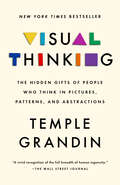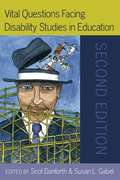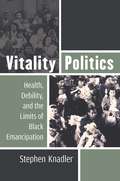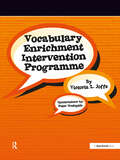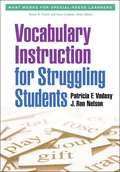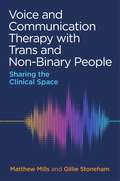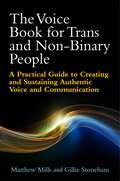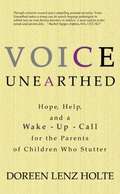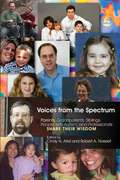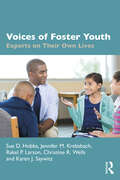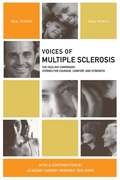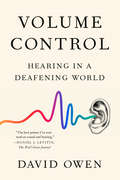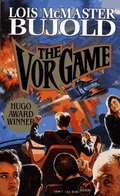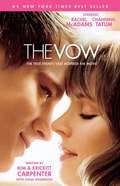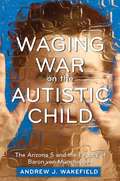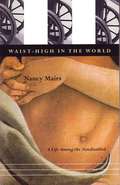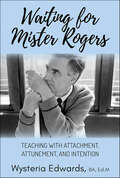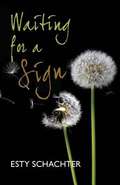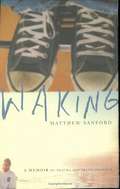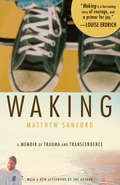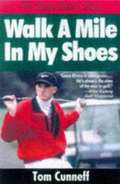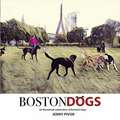- Table View
- List View
Visual Thinking: The Hidden Gifts of People Who Think in Pictures, Patterns, and Abstractions
by Temple GrandinINSTANT NEW YORK TIMES BESTSELLERWINNER OF THE NAUTILUS GOLD AWARD&“A powerful and provocative testament to the diverse coalition of minds we&’ll need to face the mounting challenges of the twenty-first century.&” —Steve Silberman &“An absolute eye-opener.&” —Frans de WaalA landmark book that reveals, celebrates, and advocates for the special minds and contributions of visual thinkersA quarter of a century after her memoir, Thinking in Pictures, forever changed how the world understood autism, Temple Grandin— &“an anthropologist on Mars,&” as Oliver Sacks dubbed her—transforms our awareness of the different ways our brains are wired. Do you have a keen sense of direction, a love of puzzles, the ability to assemble furniture without crying? You are likely a visual thinker. With her genius for demystifying science, Grandin draws on cutting-edge research to take us inside visual thinking. Visual thinkers constitute a far greater proportion of the population than previously believed, she reveals, and a more varied one, from the photo-realistic &“object visualizers&” like Grandin herself, with their intuitive knack for design and problem solving, to the abstract, mathematically inclined &“visual spatial&” thinkers who excel in pattern recognition and systemic thinking. She also makes us understand how a world increasingly geared to the verbal tends to sideline visual thinkers, screening them out at school and passing over them in the workplace. Rather than continuing to waste their singular gifts, driving a collective loss in productivity and innovation, Grandin proposes new approaches to educating, parenting, employing, and collaborating with visual thinkers. In a highly competitive world, this important book helps us see, we need every mind on board.
Visually Impaired Seniors as Senior Companions: A Reference Guide for Program Development
by Alberta L. OrrThe guide provides a framework for the reader to understand the core issues related to aging and vision loss, as well as the needs and capabilities of older visually impaired persons.
Vital Questions Facing Disability Studies in Education
by Susan L. Gabel; Scot DanforthVital Questions Facing Disability Studies in Education provides an overview and introduction to the growing field of disability studies in education, including the application of the interdisciplinary field of disability studies to inclusive education, teacher education, educational research, and educational policy development.
Vitality Politics: Health, Debility, and the Limits of Black Emancipation (Corporealities: Discourses Of Disability)
by Stephen KnadlerVitality Politics focuses on a slow racial violence against African Americans through everyday, accumulative, contagious, and toxic attritions on health. The book engages with recent critical disability studies scholarship to recognize that debility, or the targeted maiming and distressing of Black populations, is a largely unacknowledged strategy of the U.S. liberal multicultural capitalist state. This politicization of biological health serves as an instrument for insisting on a racial state of exception in which African Americans’ own unhealthy habits and disease susceptibility justifies their legitimate suspension from full rights to social justice, economic opportunity, and political freedom and equality. The book brings together disability studies, Black Studies, and African American literary history as it highlights the urgent need and gives weight to a biopolitics of debilitation and medicalization to better understand how Black lives are made not to matter in our supposedly race-neutral multicultural democracy.
Vocabulary Enrichment Programme: Enhancing the Learning of Vocabulary in Children
by Victoria JoffeThis book helps to enhance the understanding and use of vocabulary in secondary school students and young adults. Specifically designed for older children and young adults with language and communication needs, this practical language programme was created by a specialist speech & language therapist with input from secondary school teachers and students. The Vocabulary Enrichments Programme: focuses on enhancing the understanding and expression of vocabulary and word meanings in students aged from 8 to 18 aims to create an awareness of how improved vocabulary knowledge can be used to enhance learning in school and social interactions in school and home environments encourages an awareness and interest in words and language, introduces the concept of words and meanings and identifies their role and use in language, communication and social interaction introduces the word map and explore the rich networks of information attached to each word, including the meanings and make up of words using root and base words, suffixes and prefixes, synonyms and antonyms, and the etymology (origins) of words focuses on themes taken from the National Curriculum, including living and non living organisms, planet Earth and the world, the human body, emotions, healthy living, and occupations enhances the understanding and use of figurative and idiomatic language as well as more compound and complex sentence structures introduces a range of cueing techniques to aid in word retrieval. This book provide effective strategies for word learning to encourage independent word learning skills. It teaches an effective, efficient and realistic use of the dictionary as a tool for word learning and explore the role of the thesaurus in enhancing oral and written work.
Vocabulary Instruction for Struggling Students
by Patricia F. Vadasy Patricia NelsonAddressing a key skill in reading, writing, and speaking, this comprehensive book is grounded in cutting-edge research on vocabulary development. It presents evidence-based instructional approaches for at-risk students, including English language learners and those with learning difficulties. Coverage ranges from storybook reading interventions for preschoolers to direct instruction and independent word-learning strategies for older students. Guidance is provided on using word lists effectively and understanding how word features influence learning. The book also reviews available vocabulary assessment tools and describes how to implement them in a response-to-intervention framework.
Voice and Communication Therapy with Trans and Non-Binary People: Sharing the Clinical Space
by Matthew Mills Gillie StonehamSpecifically aimed at Speech and Language Therapists (SLTs) and voice practitioners, this book follows up from the authors' first book, The Voice Book for Trans and Non-Binary People. It sets out cultural competence, psychological and vocal skills, group activities and improvisations frameworks and exercises to helps SLTs develop their skills for working with trans and non-binary clients, including facilitation and coaching, emotional intelligence, role-play and solution-focused therapy, narrative therapy practices. It also includes many contributions from the trans community and a range of clinical professionals to emphasise the collaborative space.Written by two leading authorities on voice and communication therapy for trans people, this is an essential and authoritative resource for anyone working with trans and non-binary clients who are seeking their voice exploration.
The Voice Book for Trans and Non-Binary People: A Practical Guide to Creating and Sustaining Authentic Voice and Communication
by Gillie Stoneham Matthew Hotchkiss Matthew Mills Philip RobinsonWritten by two specialist speech and language therapists, this book explains how voice and communication therapy can help transgender and non-binary people to find their authentic voice. It gives a thorough account of the process, from understanding the vocal mechanism through to assimilating new vocal skills and new vocal identity into everyday situations, and includes exercises to change pitch, resonance and intonation. Each chapter features insider accounts from trans and gender diverse individuals who have explored or are exploring voice and communication related to their gender expression, describing key aspects of their experience of creating and maintaining a voice that feels true to them. This guide is an essential, comprehensive source for trans and non-binary individuals who are interested in working towards achieving a different, more authentic voice, and will be a valuable resource for speech and language therapists/pathologists, voice coaches and healthcare professionals.
Voice for the Mad: The Life of Dorothea Dix
by David GollaherThis is a comprehensive biography of a nearly forgotten social reformer of the 19th century. After her own experience with depression and recovery, Dorothea Dix became a passionate champion of the "moral treatment" popular in Europe. In her native Massachusetts she documented the horrific treatment that was the lot of most people with mental illness, and petitioned the legislature to establish asylums that would provide loving care. Dix took her crusade across the country, and for a time her work transformed psychiatric care. Gollaher describes Dix's public persona and delves into her often troubled private life as well.
Voice Unearthed: Hope, Help and a Wake-up Call for the Parents of Children Who Stutter
by Doreen Lenz HolteThe primary message young children get in stuttering therapy is that they can and should manage their speech - in other words, try to not stutter - by utilizing speech tools and techniques. Is it possible that the anxiety this causes can create an even greater burden? Can that burden lead to excessive silence and disengagement - a far greater handicap than the stuttering itself? <P><P> Through personal narrative and extensive research, Voice Unearthed answers these questions with a resounding “yes!” It also includes practical guidance that helps keep children talking while minimizing everyone’s anxiety around communicating. <P><P> Voice Unearthed frees us from the pointless, painful chore of counting speech errors and reminds us to keep our eyes on what truly matters. It’s also a wake-up call for parents, professionals, and the entire field of speech therapy – and a reminder to “first do no harm.”
Voices from the Spectrum: Parents, Grandparents, Siblings, People with Autism, and Professionals Share Their Wisdom
by Robert A. Naseef Cindy N. ArielAuthor of Could It Be Autism? A Parent's Guide to the First Signs and Next Steps Voices from the Spectrum is a compelling collection of personal accounts from people on the autism spectrum and those who care for them, including professionals, friends and family members. The essays in this collection tell of both the positive and negative effects of autism on individuals and families, and pose the question: is a diagnosis on the autism spectrum a puzzle to be solved, or something to be embraced and accepted? The broad scope of this book presents insights into the autism spectrum from many different perspectives - from first-hand accounts of the autistic child's school and childhood experiences to parents' and grandparents' reactions to a diagnosis. A number of chapters written by professionals explain their motivations for working with autistic people and reveal what they have learned from their work and how it has affected their lives. The contributors describe experiences of autism from the mildest to the most severe case, and share their methods of adapting to life on the spectrum. Voices from the Spectrum will appeal to a wide readership of adults and younger people on the autism spectrum, their families and friends, as well as practitioners.
Voices of Foster Youth: Experts on Their Own Lives
by Karen J. Saywitz Sue D. Hobbs Jennifer M. Krebsbach Rakel P. Larson Christine R. WellsThis important book offers unique insight into the experience of foster youth from 27 countries around the world. It provides a systematic review of literature reporting the experiences of youth in care, addressing a wide range of key topics in this multidisciplinary field, and presenting the views and perceptions of these young people.Including a meta-analysis on contact with birth parents, it examines youth’s experiences of the foster care system; contact and relationships; caregiving and relationships with caregivers; placements; and emotional well-being. These five core themes embrace a wide range of crucial topics including foster youth’s involvement in decisions about themselves; interactions with social workers, birth families, foster families, peers, and friends; the benefits and challenges of foster care; the stigma attached to being in care; mental health, well-being, and belonging; and developing a sense of self.This essential volume is for students and scholars of child and adolescent development, social work, education, sociology, and public health. Illustrated with quotes from former and current foster youth, and with research-based recommendations for best practices in foster care, it is also for professional social workers, psychologists, child advocates, children’s therapists, children’s attorneys, youth workers, and foster parents.
Voices of Multiple Sclerosis: Stories for Courage, Comfort and Strength
by Richard Day GoreOffering candid, heartfelt, and inspiring stories of 40 diverse individuals who have been affected by multiple sclerosis (MS), this compilation creates a connection that is vital to those dealing with the mysterious and difficult symptoms of this nerve condition. With 10,000 new cases diagnosed in the United States each year and its causes still not fully understood, these stories of personal experience act as a support group by offering advice and encouragement and creating a sense of community. The collection also features current medical information by noted experts in the fields of MS research and treatment. The resource section is packed with organizations offering hope and help for those with MS and their families and friends.
A Volcano in My Tummy: Helping Children to Handle Anger--A Resource Book for Parents, Caregivers and Teachers
by Eliane Whitehouse Warwick PutneyFrom the book jacket: Children often have problems with anger. Teachers often have problems with anger. Parents often have problems with anger. Why? Because we're afraid of anger. It may mean that someone is out of our control. It may mean that someone won't like us. It may mean that someone acts violently. This book is about living successfully, healthily, happily, nonviolently, with motivation, without fear and with good relationships. An accessible resource book for teachers, parents and all who care for children, it is full of stories, and easy-to-use games and exercises designed to encourage children to see their anger and to deal constructively with it. A Volcano in My Tummy includes sections on key concepts, building a child's self esteem, what adults can do when a child is angry, developing an anger management program, troubleshooting, and a special section for teachers that integrates the resource with other curriculum areas. Exercises are clearly described, indicating appropriate age levels, teaching strategies, materials and procedures to follow, with worksheets for the childrens' use. All are easily adaptable for use by teachers, parents or other caregivers.
Volume Control: Hearing in a Deafening World
by David OwenThe surprising science of hearing and the remarkable technologies that can help us hear betterOur sense of hearing makes it easy to connect with the world and the people around us. The human system for processing sound is a biological marvel, an intricate assembly of delicate membranes, bones, receptor cells, and neurons. Yet many people take their ears for granted, abusing them with loud restaurants, rock concerts, and Q-tips. And then, eventually, most of us start to go deaf.Millions of Americans suffer from hearing loss. Faced with the cost and stigma of hearing aids, the natural human tendency is to do nothing and hope for the best, usually while pretending that nothing is wrong. In Volume Control, David Owen argues this inaction comes with a huge social cost. He demystifies the science of hearing while encouraging readers to get the treatment they need for hearing loss and protect the hearing they still have.Hearing aids are rapidly improving and becoming more versatile. Inexpensive high-tech substitutes are increasingly available, making it possible for more of us to boost our weakening ears without bankrupting ourselves. Relatively soon, physicians may be able to reverse losses that have always been considered irreversible. Even the insistent buzz of tinnitus may soon yield to relatively simple treatments and techniques. With wit and clarity, Owen explores the incredible possibilities of technologically assisted hearing. And he proves that ears, whether they're working or not, are endlessly interesting.
The Vor Game (Miles Vorkosigan #2)
by Lois Mcmaster BujoldMiles Naismith Vorkosigan was not a mutant, though he was often mistaken for one. His home, Barrayar, was a militant world shaped by a bitter history and political strife. Years earlier, an assassin had chosen poison gas for an attack on Aral Vorkosigan, former Regent of the Barrayaran Empire -- now Prime Minister -- and the pregnant Lady Cordelia.<P><P> They survived; unborn Miles was the terrorist's only real victim. Cursed with brittle bones that neither grew nor healed properly, a dwarf-like body and a face prematurely lined with the agony of too many corrective surgeries--and too many people who could not accept his difference -- Miles refused to hide behind his Vor rank. With a brilliant mind, courage honed by a desire for adventure, and an ever-ready sense of the absurd, he carved out his own place in the galactic scheme...<P> It was just after his hard-won graduation from the Imperial Academy and before he began active duty that Miles met the hill woman. Distraught, she claimed her husband had murdered their baby daughter, who'd been born (continued on back flap) (continued from front flap) defective -- an old back-country practice for culling mutants, now illegal but impossible to stamp out. The woman demanded Lord Vorkosigan's justice, and she was no less surprised than Miles himself when he was appointed his father's Voice in the matter. But he did indeed exact justice -- for the sake of a child whose needless death would haunt him all his days...<P> Hugo Award winner.
The Vow: The True Events That Inspired the Movie
by Kim Carpenter Krickitt Carpenter Dana WilkersonLife as Kim and Krickitt Carpenter knew it was shattered beyond recognition on November 24, 1993. Two months after their marriage, a devastating car wreck left Krickitt with a massive head injury and in a coma for weeks. When she finally awoke, she had no idea who Kim was. With no recollection of their relationship and while Krickitt experienced personality changes common to those who suffer head injuries, Kim realized the woman he had married essentially died in the accident. And yet, against all odds, but through the common faith in Christ that sustained them, Kim and Krickitt fell in love all over again. Even though Kim stood by Krickitt through the darkest times a husband can ever imagine, he insists, "I'm no hero. I made a vow. " Now available in trade paper with a new chapter and photo insert, The Vow is the true story that inspired the major motion picture of the same name starring Rachel McAdams (The Notebook), Channing Tatum (Dear John), Sam Neill (Jurassic Park), and Academy Award winner Jessica Lange.
Waging War on the Autistic Child: The Arizona 5 and the Legacy of Baron von Munchausen
by Andrew J. WakefieldAs the number of children diagnosed with autism spectrum disorders grows each year, new discoveries and controversies arise. Andrew Wakefield explores many of these in his thorough investigation of the recent trial case of the "Arizona 5,” which destroyed an Arizona family. Two parents, with five children on the spectrum, were accused of Munchausen syndrome by proxy-a rare form of child abuse-and were ganged up on by physicians, child protective services, and the courts, who alleged that the parents fabricated medical symptoms in all five children. However, Wakefield now presents ample evidence that was disregarded and that would have proven the parents’ innocence.Families affected by autism suffer great hardship and prejudice, particularly as they navigate the uncertain waters of diagnosis, treatment, and education. The shocking story of the Arizona 5 family delves into the tremendous challenges some parents have to face, especially if their views on how to treat the syndrome don’t align with the medical world’s standards. Wakefield also includes numerous studies and research trials that support the controversial yet significant roles that vaccines and diet play in autism, factors many medical professionals wrongfully dismiss.
Waist-High in the World: A Life Among the Nondisabled
by Nancy MairsIn a blend of intimate memoir and passionate advocacy, Nancy Mairs takes on the subject woven through all her writing: disability and its effect on life, work, and spirit.
Waiting for Mister Rogers: Teaching with Attachment, Attunement, and Intention
by Wysteria EdwardsEvery day children enter classrooms crying out for love and relief. Waiting for Mister Rogers reveals a Kindergarten teacher's journey to find answers for the broken children entering her classroom—and the wounds in her own heart—through the personal notes, speeches, and writings of Fred Rogers. Many moments of adversity, violence, and suffering can be traced back to broken attachments in childhood. These early attachment wounds follow children into adulthood, often damaging their interpersonal relationships. Where the world offers shallow and complex solutions, the gentle work of Mister Rogers models simple and deep ways to heal insecure attachment. Waiting for Mister Rogers, answers questions of personal development and connection for anyone seeking support, such as:What do children need to be securely attached? How can teachers heal their wounds to be fully present, intentional, and effective with their students? Could student be triggering a teacher’s childhood trauma? Can teachers go deeper while doing less?It's time to remember childhood, return to the Neighborhood and teach with attachment, attunement, and intention. Mister Rogers was right all along!
Waiting For A Sign
by Esty SchachterShelly and Ian used to be close, but after Ian leaves home to attend the Hawthorne School for the Deaf, Shelly feels abandoned, and the two drift apart. <P><P> When Ian returns home with news that the future of Hawthorne is in jeopardy, Shelly isn't sure she wants him back. And Ian, who has enjoyed living with students and staff who sign all the time, feels angry when his family forgets to do the same. <P><P> An explosive argument that could drive brother and sister further apart actually offers hope for reconciliation-a hope that grows as Shelly's spirited best friend, Lisa, helps strengthen their bond. <P><P> The siblings grow closer still when they find themselves coping with an unexpected tragedy. To fully heal her relationship with Ian, however, Shelly needs to acknowledge and understand why Hawthorne-and access to the Deaf community-is so important to him. To do so, she'll need to take action and stop waiting for a sign. <P><P> Written by clinical social worker Esty Schachter, Waiting for a Sign celebrates the beauty and power of Deaf culture, offering readers an opportunity for insight and understanding.
Waking: A Memoir of Trauma and Transcendence
by Matthew SanfordThis memoir about a car accident that ended the lives of two of the author's family members and rendered the author a paraplegic describes how the surviving family members picked up the pieces of their lives, his recuperation at the Mayo Clinic, and his decision to become a disabled yoga instructor.
Waking: A Memoir of Trauma and Transcendence
by Matthew SanfordMatthew Sanford's inspirational story about the car accident that left him paralyzed from the chest down is a superbly written memoir of healing and journey—from near death to triumphant life.Matt Sanford's life and body were irrevocably changed at age 13 on a snowy Iowa road. On that day, his family's car skidded off an overpass, killing Matt's father and sister and left him paralyzed from the chest down, confining him to a wheelchair. His mother and brother escaped from the accident unharmed but were left to pick up the pieces of their decimated family.This pivotal event set Matt on a lifelong journey, from his intensive care experiences at the Mayo Clinic to becoming a paralyzed yoga teacher and founder of a nonprofit organization. Forced to explore what it truly means to live in a body, he emerges with an entirely new view of being a "whole" person. By turns agonizingly personal, philosophical, and heartbreakingly honest, this groundbreaking memoir takes you inside the body, heart, and mind of a boy whose world has been shattered. Follow Sanford's journey as he rebuilds from the ground up, searching for "healing stories" to help him reconnect his mind and his body. To do so, he must reject much of what traditional medicine tells him and instead turn to yoga as a centerpiece of his daily practice. He finds not only a better life but also meaning and purpose in the mysterious distance that we all experience between mind and body.In Waking, Sanford delivers a powerful message about the endurance of the human spirit and of the body that houses it.
Walk a Mile in My Shoes
by Tom CunneffRookie golfer Casey Martin, who suffers from a debilitating disorder that causes him to become easily fatigued, has been in the headlines lately with his lawsuit against the PGA. This book tells of the obstacles that Martin has had to overcome in his lifetime to get to where he is now.
Walk In My Shoes
by ed. Charlotte J. DewittUsher Syndrome is a rare genetic disease that causes deafblindness. This anthology includes 27 authors writing about their experiences.
